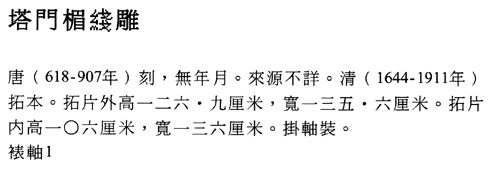 |
|
|
 |
|
|
Lintel of a
Pagoda Doorway with Finely Engraved Illustration in the Linear Manner Tang
dynasty (618�907), undated Hanging
scroll, ink rubbed on paper; 126.9 x 135.6 cm Date
of rubbing unknown Inventory number: Biaozhou 1 This
rubbing was taken from a semicircular stone lintel probably placed over the
entrance of a vaulted corridor in a Tang-dynasty pagoda.� Although the stone's origin cannot be
identified, its style of illustration is characteristically Tang and similar to
the type found in the north, south, and east doorways of the well-known Great
Wild Goose Pagoda of Ci'en Temple in Xi'an.�
Despite the lack of provenance, incised illustrations of this kind
constitute valuable materials for the study of pictorial style, stone
engraving, and Buddhist architectural ornamentation during the Tang period. A
long, very densely inscribed colophon is positioned at the lower center of the
rubbing, where a missing piece of stone translated into a corresponding blank
space.� The mass of very small
characters was written by Yao Hua (1876�1930), an artist and devout Buddhist
from Guizhou who resided at the Lotus Temple (Lianhua si) in Beijing.� The stone lintel was already damaged by the
time the rubbing was taken, and since it did not bear any kind of inscription
and was of unknown origin, Yao was unable to ascribe a date to the work, nor
could he concretely identify the Buddhist image at the center.� However, he noted that the two small flanking
figures are those of monks, the two figures with halos are bodhisattvas, and
the two at either extremity are vajras (Buddhist temple guardians).� The one at right wields a jin'gang chu
(diamond club) weighted at both ends to quell demons and is most likely a
representation of the vajra Indra. |
 |